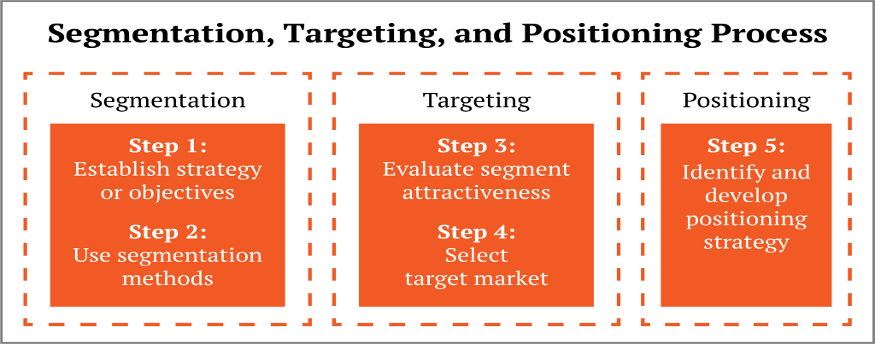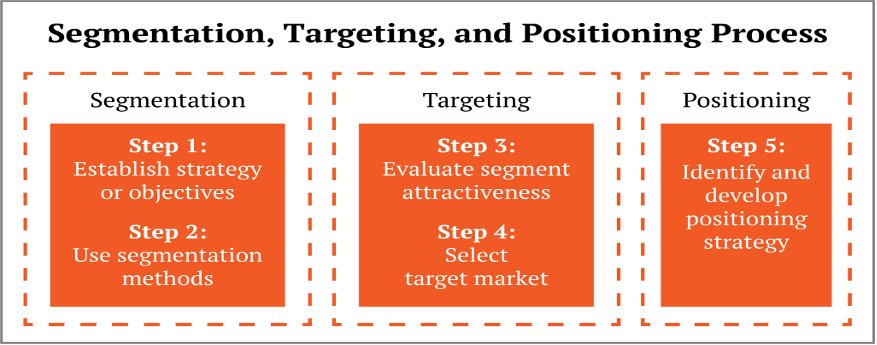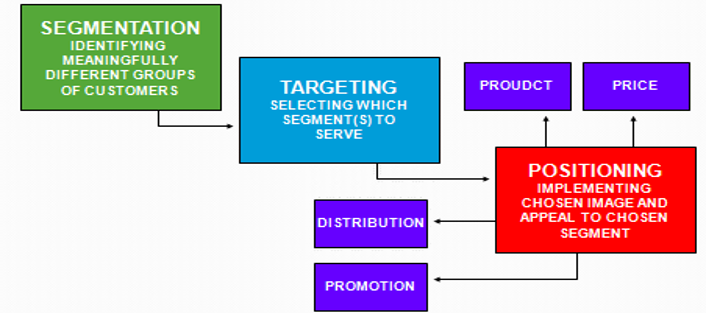1. Introduction
Segmentation, targeting, and positioning (STP) are fundamental marketing strategies that can significantly impact organizational performance (Han & Kang, 2020). According to Kalam (2020), effective STP strategies can enable a business organization to understand its customers better and create more effective marketing campaigns to enhance profitability and growth. Managers have significant roles in their organizations towards enhancing STP, including leveraging digital channels, fostering customer-centric culture, and continuously monitoring and evaluating performance (Kalam, 2020). This paper provides a detailed review of the STP concept concerning its application in the industry by focusing on the marketing strategies of the Fila Holdings Company as a case study.
2. Analysis of Segmentation, Targeting, and Positioning (STP) Concepts as a Market Strategy
The primary aim of any organization is to create value for its customers and stakeholders while attaining long-term sustainability (Thomas & George, 2021). Customer satisfaction is essential in achieving this aim, as potential customers are more likely to come back, refer others to the business, and provide positive reviews and feedback. Effective marketing strategies are essential to attaining long-term customer satisfaction. This involves conducting proper market research to comprehend customer requirements, preferences, and behaviors. This strategy contributes to a positive consumer experience, resulting in customer retention (Ningsih & Marwati, 2023). Segmentation, targeting, and positioning (STP) are the fundamental marketing concepts used to identify and analyze consumer needs and preferences and to develop a product or service that meets those needs more effectively than competitors. Kalam (2020) defines segmentation as dividing the market into smaller groups or segments based on shared characteristics such as age, gender, income, lifestyle, geographic location, and psychographic variables.

There are multiple benefits of market segmentation. By segmenting the market, businesses can determine specific consumer groups’ distinct needs, preferences, and behaviors. This information can be used to develop products or services that satisfy the unique needs of each market segment, resulting in increased customer satisfaction and loyalty (Jaiwal et al., 2020). When businesses comprehend the characteristics and requirements of each segment, they can tailor their marketing messages and strategies to each group. This can result in more successful marketing campaigns and increased response rates. Besides, focusing on specific market segments enables businesses to allocate their resources effectively in the market. This allows them to concentrate their marketing and product development efforts on the segments with the highest potential return on investment (Han & Kang, 2020). Effective market segmentation enables businesses to differentiate themselves from competitors by catering to the specific requirements of distinct customer groups with products and services. This can increase customer loyalty and bring in new consumers.
Once the market has been segmented, the next stage is to assess the potential profitability of each segment and target one or more segments accordingly. The targeting decision involves evaluating the attractiveness of each segment based on size, growth potential, competition, and the company’s capacity to meet the segment’s requirements (Varadarajan, 2020). Businesses can better understand their customers’ needs, preferences, and behaviors by identifying specific market segments (Figure 1). This enables them to better tailor their marketing messages and product offerings to their target audience’s needs. Businesses can be more resourceful when they target specific market segments with their marketing efforts. This enables them to allocate their resources, time, and endeavors more efficiently to maximize their return on investment (Oslon et al., 2021). Additionally, market targeting allows businesses to achieve a higher return on investment (ROI) because they target consumers most likely to be interested in their products or services. This means their marketing efforts are more likely to generate sales and revenue. In addition, businesses can develop a competitive advantage through this strategy (Han & Kang, 2020). Businesses can differentiate themselves from rivals and gain a competitive advantage by targeting specific market segments. They can position themselves as specialists in their niche and provide products and services tailored to their audience’s requirements.
After identifying the target market segment, the company will position the product or service to appeal to that market. Positioning entails developing an image or brand identity that differentiates the product or service from competitors and appeals to the requirements and preferences of the target market segment (Kalam, 2020). Market positioning helps develop a robust brand identity and aids consumers in recognizing and remembering the brand. It establishes a relationship between the brand and its intended audience, which can result in increased consumer loyalty and repeat business. Market positioning can also help a business separate from the competition in the market. With so many businesses offering comparable goods and services, standing out can be challenging. Market positioning can help a company separate from the competition by highlighting distinctive features, benefits, or values. Positioning on the market enables businesses to target specific customer segments based on their requirements, preferences, and behaviors (Kalam, 2020). This can result in more successful marketing campaigns and increased conversion rates. In addition, effective market positioning can increase a company’s profitability by allowing it to charge higher prices for its goods and services. Customers are willing to pay a premium when a business establishes a unique identity and value proposition.
3. Application of Segmentation, Targeting, and Positioning (STP) Concepts as a Market Strategy
Fila Holdings Corporation
Fila Holdings Corporation has operated as a global sportswear and footwear brand since 1911. The company is well-known for manufacturing high-quality athletic footwear, apparel, and accessories for athletes and sports devotees worldwide (Kim, 2016). The company effectively applies the STP to venture into various markets globally successfully. The successful implementation of the STP strategy by Fila has enabled the company to differentiate itself from competitors, effectively reach its target markets, and generate consumer loyalty and brand awareness. Fila has maintained its position as a significant sportswear and footwear brand by continuously adjusting to market trends and consumer preferences. Below is a description of how Fila applied the STP marketing strategy to venture into the global markets;

a. Market Segmentation
Fila Holdings Corporation has successfully applied the concept of segmentation as a market strategy to expand its consumer base and business. The company has implemented segmentation in multiple ways. First, Fila has segmented its products based on the sport. For instance, Fila manufactures basketball, tennis, and golf shoes and apparel. This strategy has enabled Fila to adapt to the unique requirements of each sport and attract athletes and sports enthusiasts who require specialized equipment (Kim, 2016). Secondly, Fila has segmented its product line based on gender. Men’s and women’s footwear, apparel, and accessories are manufactured by the company, with distinct characteristics to satisfy the needs of each gender. This strategy has enabled Fila to reach a broader customer base and expand its market share. Thirdly, Fila has segmented its products based on the level of performance. For instance, the company manufactures footwear for professional athletes, amateur athletes, and sports enthusiasts. This strategy has allowed Fila to increase sales by catering to the distinct requirements of each market segment. Fila has implemented both product segmentation and geographic segmentation. The company has a global presence and has tailored its marketing mix to meet the varying requirements of consumers in various regions. For instance, Fila has designed shoes and apparel in various colors and designs to cater to customers’ preferences in various regions.
b. Targeting Strategy
Fila Holdings Corporation’s well-defined marketing strategy mainly focuses on targeting specific market segments. This strategy aims to attract customers interested in purchasing high-quality sportswear and fashion items (Team, 2017). The company offers products that are specifically designed for athletes. The company also provides an extensive selection of sportswear and accessories for different sports, including tennis, golf, basketball, and running (Kim, 2016). This targeting strategy helps Fila attract customers with a passion for sports and a desire for high-quality products and those that enhance performance. Fila also targets fashion-conscious consumers. The company offers a variety of fashionable clothing that is appealing to the younger generation. The company collaborates with renowned fashion designers to create distinctive and fashionable products that appeal to customers seeking stylish and fashionable apparel (Ningsih & Marwati, 2023). Additionally, Fila targets specific geographic markets by designing products that cater to the requirements and preferences of customers in various regions. For instance, the company offers products designed mainly for the Asian market, which has different preferences regarding size and style than the Western market (Team, 2017)s. This strategy enables Fila to tailor its products to the specific requirements of consumers in various regions, which can result in increased customer loyalty and brand recognition. Fila’s strategy for attracting customers passionate about athletics and fashion has been successful. By catering to specific market segments with high-quality products, the company has developed a loyal customer base and maintained a prominent position in the competitive sportswear and fashion industry.
c. Market Positioning
As a marketing strategy, the company’s positioning emphasizes its heritage, style, and innovation. In 1911, Fila was established in Italy as a manufacturer of premium textiles. Fila has evolved into a sportswear brand but has yet to forget its origins (Kim, 2016). The company’s history plays an essential role in its positioning strategy. Fila has utilized its heritage to distinguish itself from rivals and appeal to customers who value tradition and authenticity. Style is an essential component of Fila’s positioning strategy. The business has a unique aesthetic that combines sportswear and fashion. Fila’s design is bold and striking, with bright colors, geometric patterns, and distinctive logos. The company’s emphasis on design has allowed it to appeal to a broader audience, including fashion-conscious consumers who are not necessarily avid athletes (Kim et al., 2023). Additionally, Fila has established itself as an innovative brand. The company has invested in technology and design to develop functional and fashionable products. Fila has developed, for instance, breathable fabrics that help regulate body temperature and reduce moisture (Kim, 2016). Additionally, the company has collaborated with designers and artists to create limited-edition collections that appeal to fashion-forward individuals and collectors.
4. Recommendations
The critical factor to the survival and success of any organization is its ability to comprehend its customers’ requirements and maintain their satisfaction. Based on this concept, an organization must segment the market based on needs rather than socio-economics, demographics, geodemographics, or psychographics; the organization must divide the market into groups of individuals who exhibit similar behaviors. For a segmentation scheme to be advantageous, it must not only seek to characterize consumer differences but also explain them; consequently, attitudinal segmentation can offer improved opportunities.
Organizations must first understand their customers to apply the STP marketing strategy effectively. You must conduct market research to understand better your customer’s requirements, preferences, and behaviors. This information will assist you in effectively segmenting the market and developing targeted marketing strategies. The business should then segment its market based on demographics, psychographics, geographic location, and behavioral patterns. This will enable you to tailor your marketing messages and products to specific customer groups, increasing sales and customer loyalty. After identifying the most desirable segments, develop marketing strategies that cater to each group’s unique requirements and preferences. This may include targeted advertising, personalized promotions, and customized products. In addition, creating a brand positioning strategy that distinguishes your business from competitors and resonates with your target customers is essential. This may involve highlighting distinctive product characteristics, customer service, or brand values. In addition, businesses should continuously evaluate and implement effective strategies. Rapid market conditions and consumer preferences changes necessitate constant evaluation and adaptation of marketing strategies to ensure continued success.
It is necessary to effectively manage the concepts, implementation, and application of segmentation studies because these investigations require significant time and resources. In order to successfully implement market segmentation and targeting, all employees in the organization need to be aware of the importance of doing so and involved in the process wherever it is possible for them to do so. If employees are involved in the process, they will be more committed to its implementation and results. In order to build a positioning strategy, an organization needs to determine how its competitors place themselves in the market and the various target segments. This is done through competitive positioning. Companies need to apply the four keys for successful positioning in order to meet the object of successful positioning, which includes clarity, consistency, credibility, and competitiveness. The objective of competitive positioning is to create and maintain a unique place in the market. There are two aspects: the target market and the creation of a differential advantage. Suppose an organization understands the positioning of its competitors and the potential positioning strategies available to them. In that case, it should influence its assessment regarding the attractiveness of market segments and target markets. Additionally, it may change the way in which the market is segmented, which could lead to modified target markets and positioning methods.
5. Conclusion
STP, or segmentation, targeting, and positioning, is an essential marketing strategy because it enables businesses to identify and target their ideal consumers. STP is an essential marketing strategy that helps businesses accomplish their goals by identifying and targeting the right customers, creating relevant messages, differentiating themselves from competitors, and maximizing their resources. A business can determine which categories of customers are most likely to be interested in its products or services by segmenting the market. This enables them to more efficiently and effectively target their marketing efforts. STP enables Fila Holdings to identify its various consumer segments and develop marketing messages and products for each segment. This ensures that Fila Holdings can effectively reach and engage its target audience, resulting in increased sales and consumer satisfaction. Fila Holdings can differentiate itself from competitors and emphasize its unique value proposition through positioning. This contributes to establishing a solid brand identity and increasing consumer loyalty. STP allows Fila Holdings to focus its marketing efforts on the market segments most likely to purchase its products. Fila Holdings can maximize its return on investment and increase sales and revenue by concentrating its resources on these markets. Maintaining STP as a marketing strategy can assist Fila Holdings in reaching its target audience, differentiating itself from competitors, and maximizing its resources. This can result in increased sales, revenue, and brand loyalty, all essential to the company’s long-term success.
6. References
Han, S. and Kang, E., 2020. The marketing strategy stimulates customers’ interest in the art-gallery business plan. Journal of Distribution Science, 18(8), pp.47-54. Available at: https://www.koreascience.or.kr/article/JAKO202026061031105.page [Accessed 11 April 2023]
Jaiswal, D., Kaushal, V., Singh, P.K. and Biswas, A., 2020. Greenmarket segmentation and consumer profiling: a cluster approach to an emerging consumer market. Benchmarking: An International Journal, 28(3), pp.792-812. Available at: https://www.emerald.com/insight/content/doi/10.1108/BIJ-05-2020-0247/full/html?utm_campaign=Emerald_Strategy_PPV_November22_RoN [Accessed 11 April 2023]
Kalam, K.K. (2020). Market segmentation, targeting, and positioning strategy adaptation for the global business of Vodafone Telecommunication Company. International Journal of Research and Innovation in Social Science, 4(6), pp.427–430. Available at: https://www.researchgate.net/profile/Khaled-Kalam-2/publication/342881199_Market_Segmentation_Targeting_and_Positioning_Strategy_Adaptation_for_the_Global_Business_of_Vodafone_Telecommunication_Company/links/5f0b33114585155050a04318/Market-Segmentation-Targeting-and-Positioning-Strategy-Adaptation-for-the-Global-Business-of-Vodafone-Telecommunication-Company.pdf [Accessed 11 April 2023]
Kim, S.J., Yoo, J. and Ko, E., (2023). The effects of brand collaboration with the online game on customer equity and purchase intention: the moderating effect of fashion brand type. Asia Pacific Journal of Marketing and Logistics. Available at: https://www.emerald.com/insight/content/doi/10.1108/APJML-03-2022-0279/full/html [Accessed 11 April 2023]
Kim, G. (2016, June 5). Fila strategic plan. Issuu. Retrieved April 11, 2023, from https://issuu.com/miss7220/docs/fila_strategicplanrough
Ningsih, K. and Marwati, T.A., 2023. Marketing Strategy Analysis Based on Segmenting, Targeting, and Positioning in Hospital. Disease Prevention and Public Health Journal, 17(1), pp.47-54. Available at: http://www.journal2.uad.ac.id/index.php/dpphj/article/view/6420 [Accessed 11 April 2023]
Olson, E.M., Olson, K.M., Czaplewski, A.J. and Key, T.M., 2021. Business strategy and the management of digital marketing. Business Horizons, 64(2), pp.285-293. Available at: https://www.sciencedirect.com/science/article/pii/S0007681320301567 [Accessed 11 April 2023]
Team, M. 2017. Fila Marketing Strategy & Marketing Mix (4PS). MBA Skool. Retrieved April 11, 2023, from https://www.mbaskool.com/marketing-mix/products/17255-fila.html
Thomas, M.R. and George, G., 2021. Segmenting, targeting, and positioning (stp) generational cohorts Y, Z, and Alpha. IIMS Journal of Management Science, 12(2), pp.115-129.Available at: https://www.indianjournals.com/ijor.aspx?target=ijor:iimsjms&volume=12&issue=2&article=004 [Accessed 11 April 2023]
Varadarajan, R., 2020. Customer information resources advantage, marketing strategy, and business performance: A market resources based view. Industrial Marketing Management, 89, pp.89-97. Available at: https://www.sciencedirect.com/science/article/pii/S0019850120300389 [Accessed 11 April 2023]
7. Appendix



 write
write